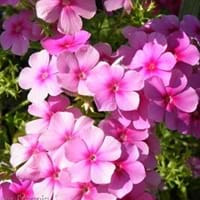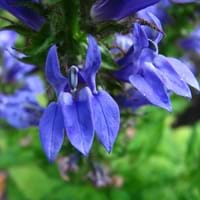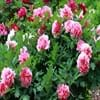Life Span
Perennial
Annual
Type
Perennial
Flowering Plants, Shrubs
Origin
Northeastern United States, Mid-Atlantic United States, Southeastern United States, North-Central United States, Central United States, South-Central United States, Canada
America
Types
Phlox divaricata,Phlox buckleyi, Phlox paniculata
Lobelia aberdarica, Lobelia leschenaultiana, Lobelia canbyi
Habitat
Loamy soils, meadows, moist forests
Open areas, River side, Woods
USDA Hardiness Zone
4-8
4-9
Sunset Zone
1a, 1b, 2a, 2b, 3a, 3b, 4, 5, 6, 7, 8, 9, 10, 11, 12, 13, 14, 18, 19, 20, 21
A1, A2, A3, H1, H2, 1a, 1b, 2a, 2b, 3a, 3b, 4, 5, 6, 7, 8, 9, 10, 11, 12, 13, 14, 15, 16, 17, 18, 19, 20, 21, 22, 23, 24
Habit
Upright/Erect
Cushion/Mound-forming
Flower Color
Pink, Violet
Blue, Red, Violet, White
Flower Color Modifier
Not Available
Bicolor
Fruit Color
Not Available
Not Available
Leaf Color in Spring
Green
Dark Green
Leaf Color in Summer
Green
Green
Leaf Color in Fall
Green
Green
Leaf Color in Winter
Not Available
Not Available
Leaf Shape
Oblong
Cushion
Plant Season
Summer, Fall
Fall, Summer
Sunlight
Full Sun, Partial Sun
Full Sun, Partial shade
Type of Soil
Clay, Loam, Sand
Well drained
The pH of Soil
Acidic, Neutral, Alkaline
Acidic
Soil Drainage
Well drained
Well drained
Bloom Time
Summer, Late Summer, Early Fall, Fall
Early Fall, Early Summer, Late Summer, Mid fall, Mid Spring
Tolerances
Not Available
Not Available
Where to Plant?
Container, Ground
Container, Ground, Pot
How to Plant?
Seedlings, Transplanting
Seedlings
Plant Maintenance
Medium
Medium
Watering Requirements
Do Not over Water, Keep ground moist
Form a Soil ring to water efficiently, Prefer drip-irrigation instead of Over-head watering, Requires watering in the growing season, Use Mulches to help prevent water loss during hot and windy weather, Water twice a day in the initial period
In Summer
Lots of watering
Lots of watering
In Spring
Adequately
Moderate
In Winter
Average Water
Average Water
Soil pH
Acidic, Neutral, Alkaline
Acidic
Soil Type
Clay, Loam, Sand
Well drained
Soil Drainage Capacity
Well drained
Well drained
Sun Exposure
Full Sun, Partial Sun
Full Sun, Partial shade
Pruning
Remove damaged leaves, Remove dead branches, Remove dead leaves
Cut or pinch the stems, Prune after flowering, Prune to control growth, Remove dead or diseased plant parts, Remove deadheads
Fertilizers
All-Purpose Liquid Fertilizer, Apply 10-10-10 amount
All-Purpose Liquid Fertilizer
Pests and Diseases
Leafhoppers, Pink Root, Powdery mildew, Red blotch
Botrytis Blight, Crown rot, Pythium rot, Stem spot
Plant Tolerance
Drought
Drought
Flower Petal Number
Single
Single
Foliage Texture
Medium
Fine
Foliage Sheen
Matte
Matte
Attracts
Bees, Butterflies, Hummingbirds
Birds, Hummingbirds
Allergy
allergic conjunctivitis, breathing problems, Irritate the mucus membrane
coma, convulsions, Diarrhea, exhaustion, Nausea, salivation, Vomiting, weakness
Aesthetic Uses
Beautification, Cottage Garden
Beautification, Bouquets, Showy Purposes, Used for decorating walls, fences, gates, hedges, etc.
Beauty Benefits
Improve skin tone, Restores Hair Colour, Skin cleanser
Not Available
Environmental Uses
Air purification, Increases moisture in air, Prevent Soil Erosion
Air purification
Medicinal Uses
Aging, Antispasmodic
Asthma, Bronchitis, Croup
Part of Plant Used
Leaves
Leaves, Seeds
Other Uses
Air freshner, Cosmetics, Making Sweet Scented Oil
Showy Purposes
Used As Indoor Plant
Sometimes
Yes
Used As Outdoor Plant
Yes
Yes
Garden Design
Cutflower, Mixed Border, Wildflower
Bedding Plant, Bog Garden, Edging, Foundation, Hanging Basket, Houseplant, Mixed Border, Rock Garden / Wall
Botanical Name
PHLOX paniculata 'Robert Poore'
Lobelia laxiflora
Common Name
Garden Phlox
Lobelia
In Portuguese
Phlox
Lobélia
Phylum
Spermatophyta
Anthophyta
Class
Magnoliopsida
Dicotyledonae
Order
Solanales
Asterales
Family
Polemoniaceae
Campanulaceae
Clade
Not Available
Angiosperms, Asterids, Eudicots
Tribe
Not Available
Not Available
Subfamily
Not Available
Lobelioideae
Importance of Garden Phlox and Lobelia
Want to have the most appropriate plant for your garden? You might want to know the importance of Garden Phlox and Lobelia. Basically, these two plants vary in many aspects. Compare Garden Phlox and Lobelia as they differ in many characteristics such as their life, care, benefits, facts, etc. Every gardener must at least have the slightest clue about the plants he wants to plant in his garden. Compare their benefits, which differ in many ways like facts and uses. The medicinal use of Garden Phlox is Aging and Antispasmodic whereas of Lobelia is Asthma, Bronchitis and Croup. Garden Phlox has beauty benefits as follows: Improve skin tone, Restores Hair Colour and Skin cleanser while Lobelia has beauty benefits as follows: Improve skin tone, Restores Hair Colour and Skin cleanser.
Compare Facts of Garden Phlox vs Lobelia
How to choose the best garden plant for your garden depending upon its facts? Here garden plant comparison will help you to solve this query. Compare the facts of Garden Phlox vs Lobelia and know which one to choose. As garden plants have benefits and other uses, allergy is also a major drawback of plants for some people. Allergic reactions of Garden Phlox are allergic conjunctivitis, breathing problems and Irritate the mucus membrane whereas of Lobelia have coma, convulsions, Diarrhea, exhaustion, Nausea, salivation, Vomiting and weakness respectively. Having a fruit bearing plant in your garden can be a plus point of your garden. Garden Phlox has no showy fruits and Lobelia has no showy fruits. Also Garden Phlox is not flowering and Lobelia is flowering. You can compare Garden Phlox and Lobelia facts and facts of other plants too.





